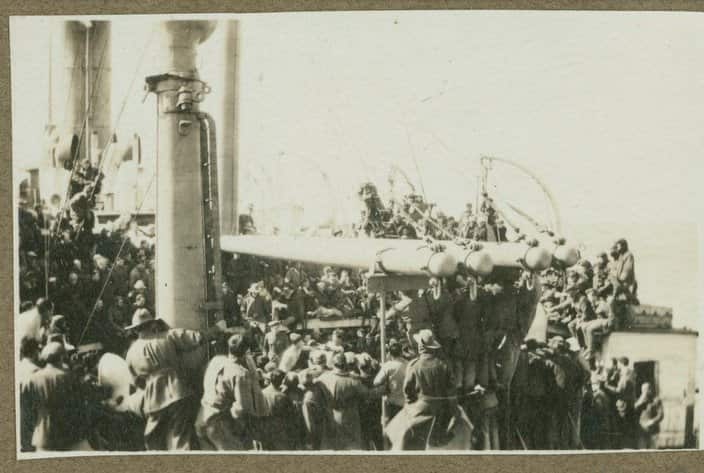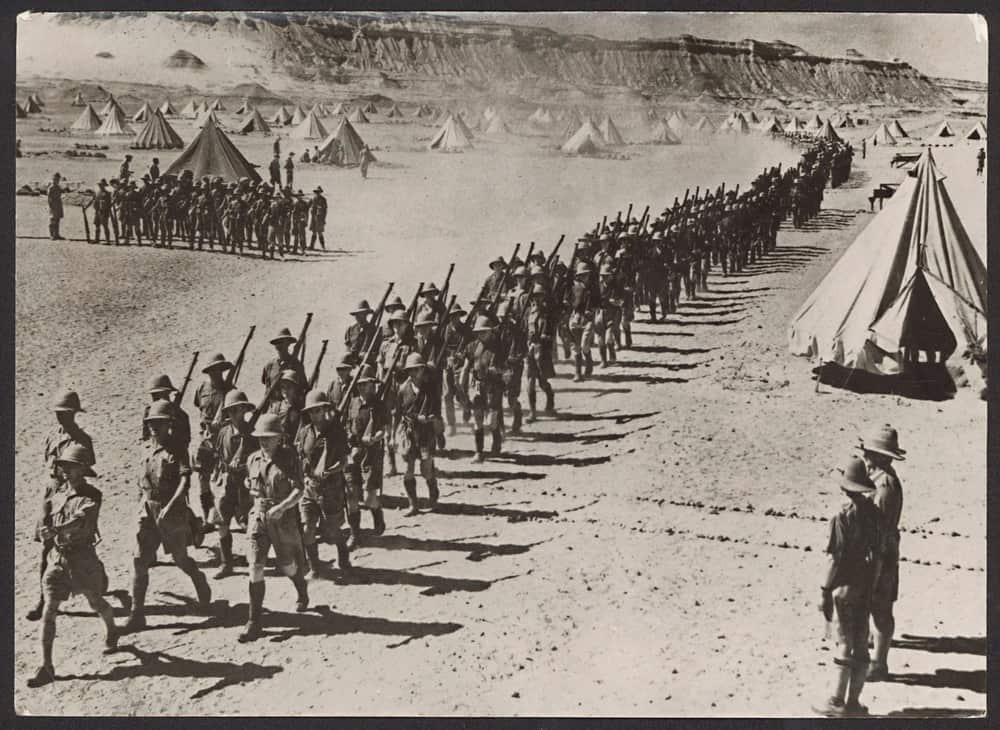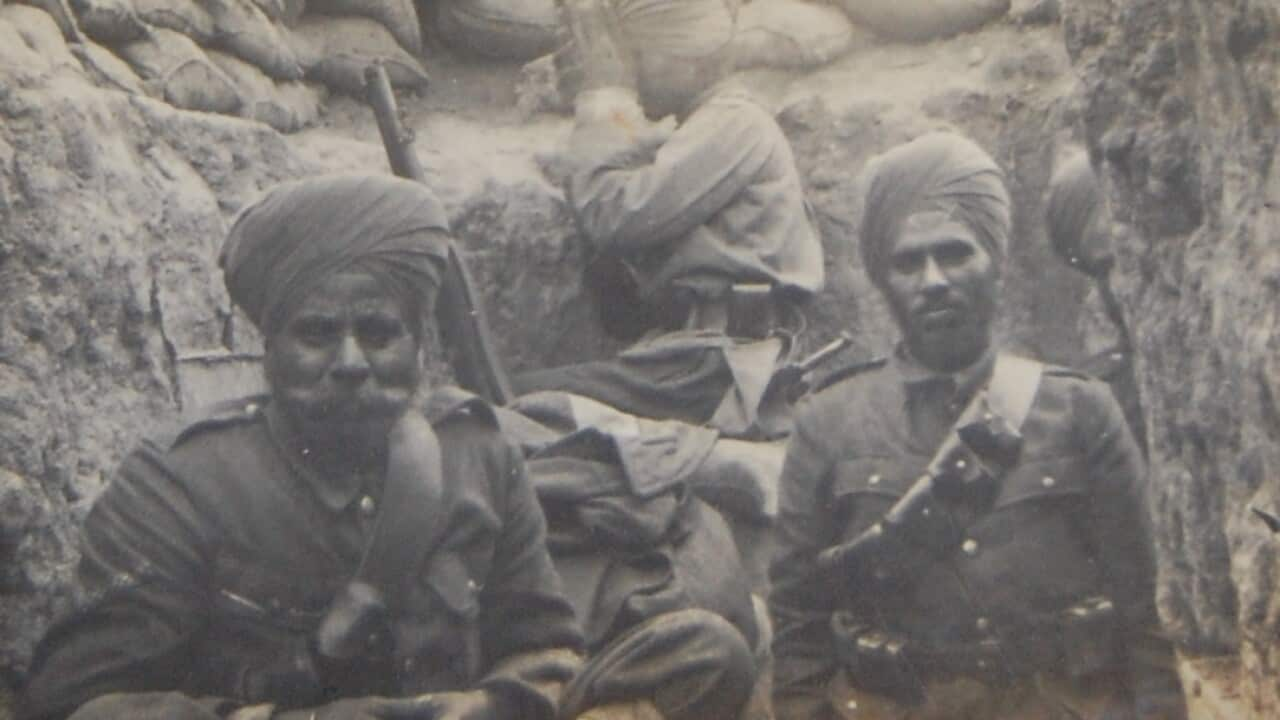A memorial commemorating the contribution of Indian soldiers who served in the Australian Imperial Force (AIF) will be unveiled in Sydney on Saturday.
The memorial-the first of its kind in NSW- has been constructed by the Hindu Council of Australia with the support of MP Julian Leeser, Hornsby RSL-Sub Branch and other local community organisations, with a grant from the Department of Veterans’ Affairs.
The memorial has been constructed to draw attention towards the lesser known history and sacrifices made by the Indian military personnel who fought alongside the ANZAC forces during World War I (WWI).

Source: Supplied
Background and History:
Some of them were deployed overseas in Europe, Egypt and other theatres of war, going on to serve to nation honourably, with two laying down their lives in Belgium during June 1917. Others faced disciplinary action, and others still were dismissed from the AIF for disobedience, medical reasons or because the soldier was “not of substantially European descent.” But that was indeed the time, when the White Australia policy was implemented in all walks of life.
Despite that, 12 men of Indian origin were recorded as Australian soldiers by recruiting authorities during WWI.
“The Australian Imperial Force was founded in August 1914,” says noted historian Prof Peter Stanley. “It was specifically created as a volunteer force which would serve overseas for the duration of the war.” The AIF was later disbanded in 1920, after all the deployed soldiers had returned to Australia and records indicate that all the Indian Anzacs were discharged by the end of 1918. Of the 12 Indian Anzacs recruited by the AIF, Private Sirdar Singh of 3rd Light Horse seems to be the only one who received a promotion while in service. He was made a Lance Corporal in January 1918, but within months, he was demoted and was made a Trooper again. “The 3rd Light Horse served in the Middle East, deployed in places like Cairo and Palestine,” says Stanley. “Those soliders were never sent to Europe. It is possible that while serving in Egypt, the AIF needed an expereiced soldier to become an NCO (a non-commissioned officer) to take on additional charges. They weren’t paid any additional money for it, but were given additional responsibilities. Its quite possible that in a few months time, the AIF didn’t need to continue Sirdar Singh’s service as a Lance Corporal and demoted him, or maybe he wasn’t good enough. The records just don’t reveal why Sirdar Singh was remanded to Private, but obviously, the AIF had the authority to promote or demote anyone for reasons best known to them.”
Of the 12 Indian Anzacs recruited by the AIF, Private Sirdar Singh of 3rd Light Horse seems to be the only one who received a promotion while in service. He was made a Lance Corporal in January 1918, but within months, he was demoted and was made a Trooper again. “The 3rd Light Horse served in the Middle East, deployed in places like Cairo and Palestine,” says Stanley. “Those soliders were never sent to Europe. It is possible that while serving in Egypt, the AIF needed an expereiced soldier to become an NCO (a non-commissioned officer) to take on additional charges. They weren’t paid any additional money for it, but were given additional responsibilities. Its quite possible that in a few months time, the AIF didn’t need to continue Sirdar Singh’s service as a Lance Corporal and demoted him, or maybe he wasn’t good enough. The records just don’t reveal why Sirdar Singh was remanded to Private, but obviously, the AIF had the authority to promote or demote anyone for reasons best known to them.” Records show that during WWI, five of the Indian-origin soldiers were recruited in South Australia, four in New South Wales, two in Western Australia and one in Victoria. Of these, at least three of them were never involved in any active service, and dismissed within a short time of recruitment for reasons like “unlikely to become an efficient soldier” or “unsuitable physique”, or as in the case of Linna Singh, who enlisted at the 44th Depot in Perth and was rejected because he was “not of substantially European descent.” Peter Stanley thinks, that the recruiting officer “enforced the letter of the Defence Act, which formally prohibited non-white men from being accepted.”
Records show that during WWI, five of the Indian-origin soldiers were recruited in South Australia, four in New South Wales, two in Western Australia and one in Victoria. Of these, at least three of them were never involved in any active service, and dismissed within a short time of recruitment for reasons like “unlikely to become an efficient soldier” or “unsuitable physique”, or as in the case of Linna Singh, who enlisted at the 44th Depot in Perth and was rejected because he was “not of substantially European descent.” Peter Stanley thinks, that the recruiting officer “enforced the letter of the Defence Act, which formally prohibited non-white men from being accepted.” In another instance, the letter of the Defence Act was fully enforced and worked both ways for Pte Juwan Singh of SA. He was recruited in November 1916 and was supplied with lower dentures, as per the rules. But within a month of joining, he was "admonished for disobedience" and early in 1917, he was discharged from AIF.
In another instance, the letter of the Defence Act was fully enforced and worked both ways for Pte Juwan Singh of SA. He was recruited in November 1916 and was supplied with lower dentures, as per the rules. But within a month of joining, he was "admonished for disobedience" and early in 1917, he was discharged from AIF.

Australian troops returning home after WWI ended; a snapshot when they crossed the Equator Source: State Library of Victoria

British and allied forces in North Africa; Image H99 Source: State Library of Victoria

From the AIF records of Pte Linna Singh Source: NAA
On the other hand, there are great stories of valour and sacrifice made by these Indian Anzacs, who swore allegiance to the Australian flag during WWI. Many of them were awarded medals for their bravery and service to the nation, most commonly earning the British War Medal and the Victory Medal and sometimes also the 1914/15 Star. Most of them were previously hawkers, labourers or farmers, and some of them had previously served for the British Indian Army. Like most (about 75%) AIF volunteers, most Indians were unmarried, with only two of the twelve citing names of their wives in Australia at the time of enlistment. Pte Davy Singh, who was born in Lahore, stated that his wife’s name was Janey Singh of Newcastle (NSW) and their son’s name was Tommy Singh. Similarly Hazara Singh who served in 3rd Light Horse was married to Ada Singh, and also belonged to NSW. Perhaps another very interesting fact pertaining to these Indian Anzacs is the religion or denomination noted in their records at the time of enlistment. Gurbachan Singh (born in Jandiala near Jullundur) is denoted as belonging to the Church of England, Linna Singh (born in Punjab) is marked as a Roman Catholic. Desanda Singh, Ganessa Sigh, Hazara Singh Juwan Singh, and Sirdar Singh have either “Sikh” or “Singh” denoted as their religion, whilst Davy Singh (born Lahore), Nain Singh Sailani (born Simla), Nundah Singh (born Punjab) and Sarn Singh (born Jullundur) are all marked as “Hindoo”. In fact there are two separate enlistment records for Sarn Singh, one denoting him as Hindoo and another stating Church of England in all probability.
Perhaps another very interesting fact pertaining to these Indian Anzacs is the religion or denomination noted in their records at the time of enlistment. Gurbachan Singh (born in Jandiala near Jullundur) is denoted as belonging to the Church of England, Linna Singh (born in Punjab) is marked as a Roman Catholic. Desanda Singh, Ganessa Sigh, Hazara Singh Juwan Singh, and Sirdar Singh have either “Sikh” or “Singh” denoted as their religion, whilst Davy Singh (born Lahore), Nain Singh Sailani (born Simla), Nundah Singh (born Punjab) and Sarn Singh (born Jullundur) are all marked as “Hindoo”. In fact there are two separate enlistment records for Sarn Singh, one denoting him as Hindoo and another stating Church of England in all probability.

Medals won by Pte Ganessa Singh for his service in AIF during WWI Source: From the private collection of Gurmit Singh
. Peter Stanley explains this as a common discrepancy back then. “The correct recording of anyone’s religion depended on the recruiting sergeant and his knowledge of the religions of India. It is quite possible that the sergeant may have asked the person who turned up for recruitment about his religion, didn’t understand the answer, and just because they were from India, wrote down Hindoo. Or due to their own 'default setting', marked them as Roman Catholic or Church of England. It also very plausible that the person being recruited wasn’t fully conversant in English and couldn’t read what was written down as his religion. So things like these are not surprising, and can’t be taken literally.”
Peter Stanley explains this as a common discrepancy back then. “The correct recording of anyone’s religion depended on the recruiting sergeant and his knowledge of the religions of India. It is quite possible that the sergeant may have asked the person who turned up for recruitment about his religion, didn’t understand the answer, and just because they were from India, wrote down Hindoo. Or due to their own 'default setting', marked them as Roman Catholic or Church of England. It also very plausible that the person being recruited wasn’t fully conversant in English and couldn’t read what was written down as his religion. So things like these are not surprising, and can’t be taken literally.”

One set of AIF records showing Sarn Singh as a Hindoo Source: NAA
It should be noted that while a few of the Indian origin volunteers joining the AIF during WWI could sign their own names, as evidenced in the enlistment forms, many records show that the recruiting agents themselves signed for the newly enlisted Indian Anzacs. This may point to an inability of the Indian born soldiers in AIF, to read and write English. Stanley agrees as he says, "While a vast majority of the Australian soldiers were literate, the literacy rate among the Indian recruits was very low." There is another interesting record of George Sims, who was formerly known as Johar Singh. He stated that he was born in Hebel, Queensland, and enlisted from Melbourne in July 1915, with his religion marked as “Roman Catholic”. He probably is the first person of Indian origin to join the AIF, with the recruitment form clearly stating he had “substantially European origin.” But he was later discharged in March 1916, without undertaking much active duty. The reason for his discharge at Broadmeadows on 26/03/16, is stated as “services no longer required”. Peter Stanley believes, “Its possible that Geroge Sims was of mixed race – there was a substantial Christian minority in South India.”
There is another interesting record of George Sims, who was formerly known as Johar Singh. He stated that he was born in Hebel, Queensland, and enlisted from Melbourne in July 1915, with his religion marked as “Roman Catholic”. He probably is the first person of Indian origin to join the AIF, with the recruitment form clearly stating he had “substantially European origin.” But he was later discharged in March 1916, without undertaking much active duty. The reason for his discharge at Broadmeadows on 26/03/16, is stated as “services no longer required”. Peter Stanley believes, “Its possible that Geroge Sims was of mixed race – there was a substantial Christian minority in South India.” As for how one military personnel could have multiple recruitment records, Stanley says, ”Everything was recorded by hand in those days. Its quite posible that someone came for recruitment one day, was turned away , but recalled later. A second form could be created then. Or multiple forms could be created at various sections within the AIF, because everything was paper-based. But the fact is, that Australia really desperately needed to recruit volunteers during WWI and some of them did come from multicultural backgrounds, despite the White Australia Policy.”
As for how one military personnel could have multiple recruitment records, Stanley says, ”Everything was recorded by hand in those days. Its quite posible that someone came for recruitment one day, was turned away , but recalled later. A second form could be created then. Or multiple forms could be created at various sections within the AIF, because everything was paper-based. But the fact is, that Australia really desperately needed to recruit volunteers during WWI and some of them did come from multicultural backgrounds, despite the White Australia Policy.” Below is a snapshot of all twelve soldiers of Indian origin who volunteered to join the Australian Imperial Force during WWI, based on records at the National Archives of Australia. Each AIF member is mentioned by the order of recruitment.
Below is a snapshot of all twelve soldiers of Indian origin who volunteered to join the Australian Imperial Force during WWI, based on records at the National Archives of Australia. Each AIF member is mentioned by the order of recruitment.

Another set of AIF records suggesting that Sarn Singh belonged to Church of England Source: NAA

Record for George Sims, previous known as Johar Singh. He may well be the first Indian origin Anzac, who joined AIF in July 1915 Source: NAA

British and allied forces in Northern Africa during WWI Source: NAA
George Sims aka Johar Singh 13/ 7th Battalion
Born Hebel (Qld), enlisted 22/7/1915 at Melbourne, Vic.
Age: 28 years
Profession: Contractor
Unmarried
Religion: Roman Catholic
Hazara Singh 13th Battalion
Born Lahore (United India)
Enlisted 06/01/1916 in Liverpool NSW. Multiple enlistment forms archived.
Father Dilip Singh in Lahore
Age: 33 years
Profession: Store-keeper
Wife: Ada Singh
Religion: Sikh
Previous service for British Indian Army: served in Burma for 5 years and service in 32nd Sikhs during Afghanistan war also recorded in another recruitement form.
Discharged 20/06/1918 because he was overage and deemed “medically unfit”.
Linna Singh, 44 Depot (assigned 5 MD but no military service record).
Born Punjab “near Delhi”
Enlisted on 04/01/1916 at Perth, WA
Age: 45 years
Profession: Traveller
Was legally separated from wife Amelia Singh and son was at Arenja orphanage with unknown address.
Religion: Roman Catholic
Previously served in Indian army for over 6 years.
Discharged because he was “not of substantially European descent”
Nain Singh Sailani, 44th Battalion
Born Simla (India) enlisted 7/2/1916 at Perth, WA
Age: 43years
Profession: Labourer
Unmarried
Religion: Hindoo
Killed in Action in Belgium 01/06/1917
Buried with honour at the Strand Military Cemetery in Ploegsteert Wood, Belgium - in plot 2, Grave 10.
Davy singh, 33rd Battalion
Born Lahore (United India) enlisted 12/2/1916 at Inverell NSW
Age: 34 years
Profession: hawker
Wife Janey Singh in Newcastle, NSW, had son named Tommy Singh
Religion: Hindoo
Discharged from AIF in Sydney, declared medically unfit. Settled in Boolaroo afterwards
Gurbachan Singh 3rd battalion and 56th Battalion
Born Jandiala near Jullundur, brother’s name Indarar Singh
Enlisted on 5/04/1916 in Sydney NSW
Age: 43 years
Profession: Dealer
Unmarried
Religion: Church of England
Discharged 04/06/1918.
Sarn Singh 43rd Battalion
Born Jullundur, Wife Partop (also written as Pardab) Kaur
Enlisted 15/05/1916 at Adelaide SA
Age 33 years,
Religion: Multiple records – one denotes Church of England, another says Hindoo.
Killed in Action in Belgium 10/06/1917 Ganessa Singh 10th Battalion
Ganessa Singh 10th Battalion

Medals awarded to Sarn Singh for his service to AIF Source: NAA
Born Punjab (brothers Myea Singh and Kurtar Singh – Raipur Doaba, Tehsil Nawashehar, dist Jullundur)
Enlisted 11/09/1916 at Adelaide, SA
Age 37 years
Profession: Farmer.
Unmarried
Religion: Sikh
Served overseas, discharged 20/09/1918
Sirdar Singh 3rd Light Horse
Born Doosanjh Punjab, brother Chanunn Singh in Doosanjh named next of kin
Enlisted 08/10/1917 in Adelaide, SA
Age: 39 years
Profession: Merchant
Unmarried
Religion: Sikh
Previously served 4 yrs 7 months for 16th Bengal Lancers in India
Promoted to Lance Corporal in Jan 1918, but was reverted back to trooper in April. Discharged for “family reasons” on 10/10/1918 after service of 1 year 3 days including 212 days overseas.
On 10/07/1918 an urgent message was sent from Egypt, urgently requesting that Sirdar Singh and Desanda Singh be returned to Australia. “Considered inadvisable to retain Troopers Singh Desanda, Singh Sirdar, enlisted Adelaide 3 LH, owing to peculiar conditions in this theatre. Request permission to return them to Australia. Treat as Urgent.” Commander in Chief approved, and both returned to Australia by the Wiltshire.
Desanda Singh 3rd Light Horse
Born Punjab (brother’s name Chunda Singh, Kapurthala)
Enlisted 1/11/1917 at Adelaide, SA
Age: 38 years
Profession: Farmer
Unmarried
Religion: Singh
Juwan Singh 3rd Light Horse
Enlisted 5/11/1917 at Adelaide, SA
Born Ladhran (Punjab, India)
Age: 41 years
Profession: Farmer and horse dealer
He knew Sirdar Singh of Adelaide
Widower. Had a son named Purtan Singh back home in Punjab.
Religion: Singh
Was supplied lower dentures by AIF upon recruitment, as per law.
On 14/12/1917 was “admonished for disobedience of orders”.
Discharged 08/02/1918 with the notation “Unlikely to become an efficient soldier”.
Nundah Singh
Born Lahore (United India) , brother Partab Singh named next of kin
Enlisted 25/01/1918 at Darlinghurst NSW
Age: 35 years
Profession: farmer
Widower
Religion: Hindoo
On 26/02/1918 found unfit for service because of “unsuitable physique”. (Interestingly, records show he is taller and better built than some other Indian Anzacs)
More articles, interviews and videos from SBS Punjabi

Charting Australia's historical military connections with India




